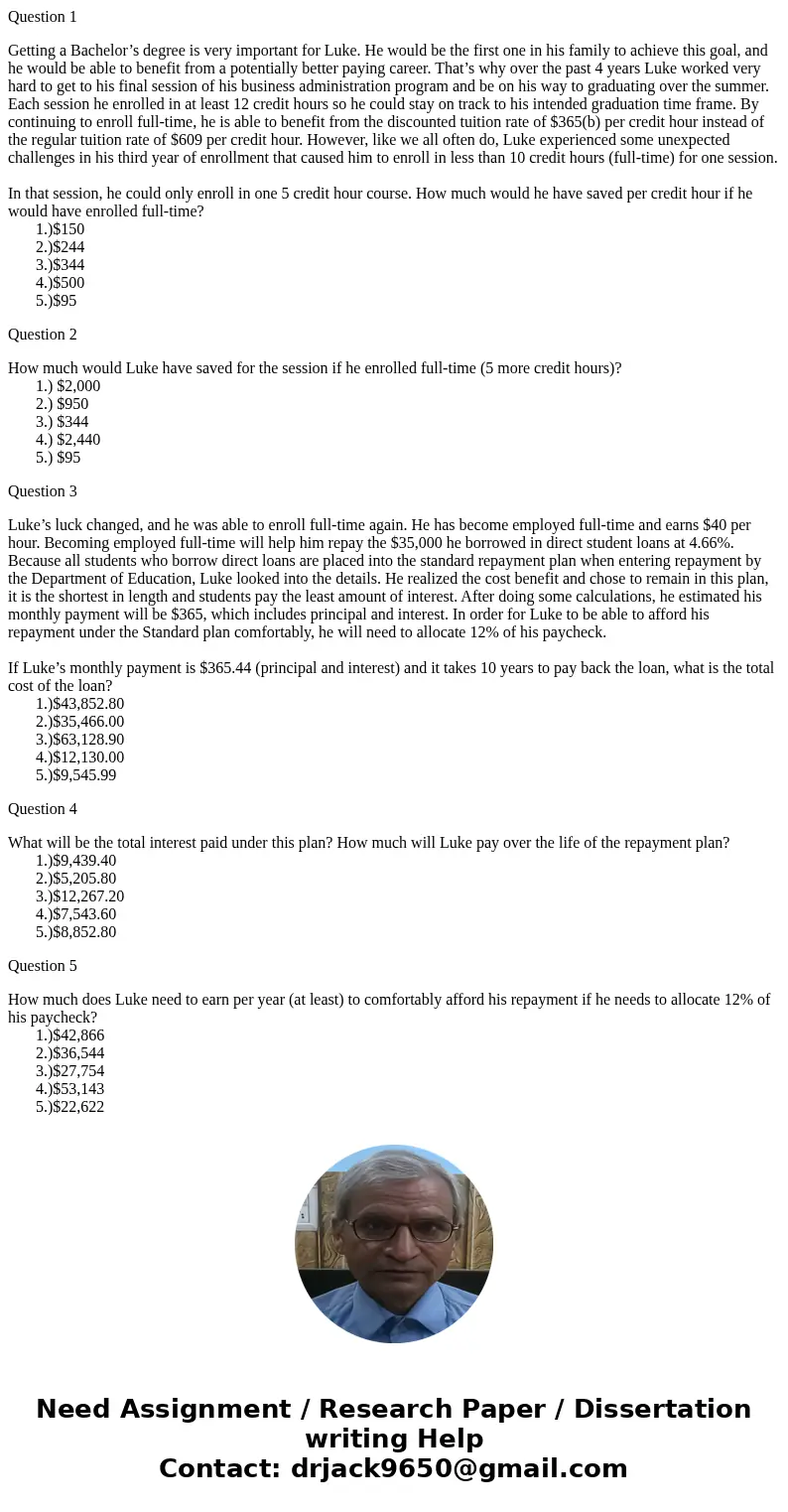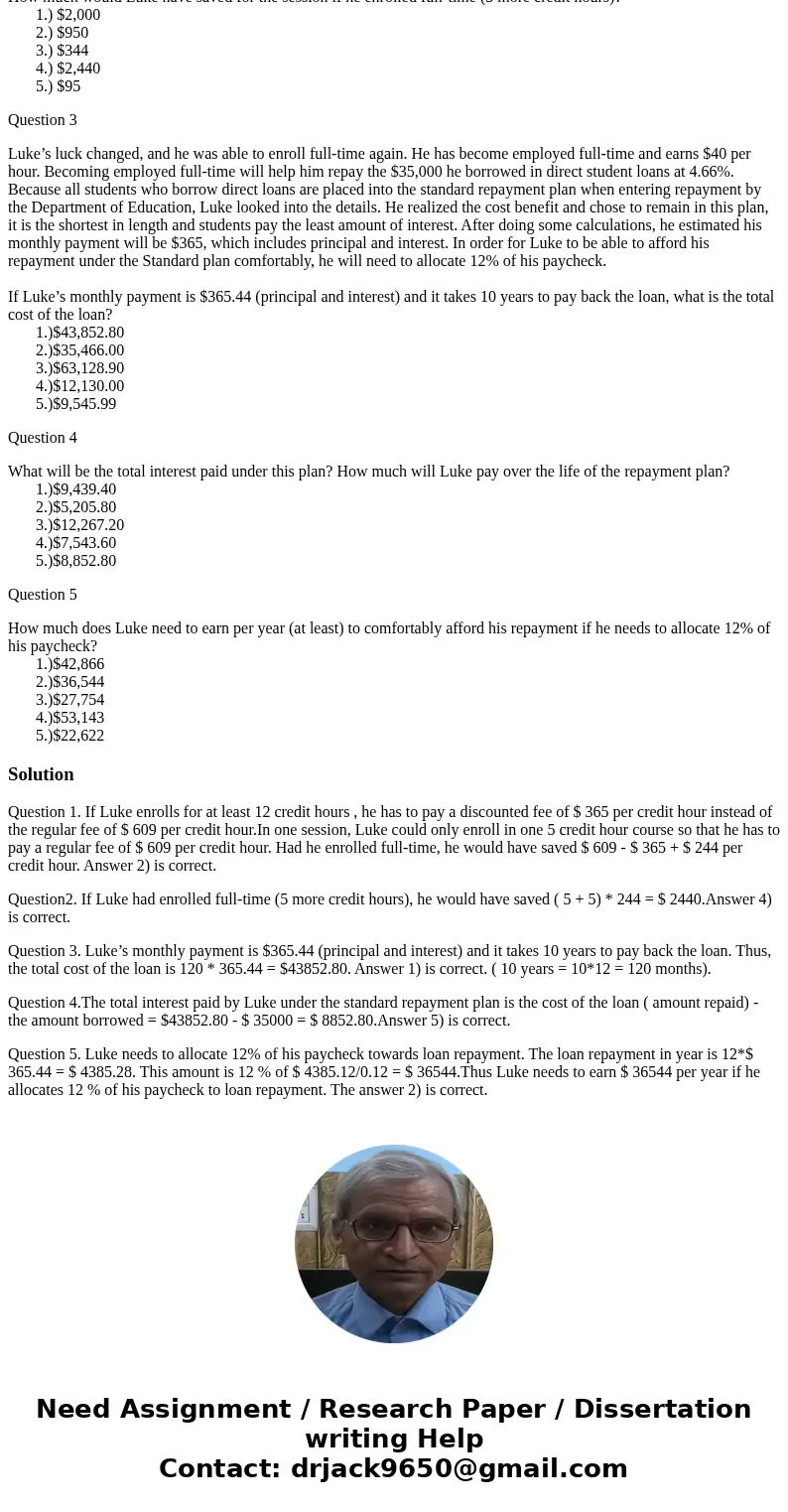Question 1 Getting a Bachelors degree is very important for
Question 1
Getting a Bachelor’s degree is very important for Luke. He would be the first one in his family to achieve this goal, and he would be able to benefit from a potentially better paying career. That’s why over the past 4 years Luke worked very hard to get to his final session of his business administration program and be on his way to graduating over the summer. Each session he enrolled in at least 12 credit hours so he could stay on track to his intended graduation time frame. By continuing to enroll full-time, he is able to benefit from the discounted tuition rate of $365(b) per credit hour instead of the regular tuition rate of $609 per credit hour. However, like we all often do, Luke experienced some unexpected challenges in his third year of enrollment that caused him to enroll in less than 10 credit hours (full-time) for one session.
In that session, he could only enroll in one 5 credit hour course. How much would he have saved per credit hour if he would have enrolled full-time?
1.)$150
2.)$244
3.)$344
4.)$500
5.)$95
Question 2
How much would Luke have saved for the session if he enrolled full-time (5 more credit hours)?
1.) $2,000
2.) $950
3.) $344
4.) $2,440
5.) $95
Question 3
Luke’s luck changed, and he was able to enroll full-time again. He has become employed full-time and earns $40 per hour. Becoming employed full-time will help him repay the $35,000 he borrowed in direct student loans at 4.66%. Because all students who borrow direct loans are placed into the standard repayment plan when entering repayment by the Department of Education, Luke looked into the details. He realized the cost benefit and chose to remain in this plan, it is the shortest in length and students pay the least amount of interest. After doing some calculations, he estimated his monthly payment will be $365, which includes principal and interest. In order for Luke to be able to afford his repayment under the Standard plan comfortably, he will need to allocate 12% of his paycheck.
If Luke’s monthly payment is $365.44 (principal and interest) and it takes 10 years to pay back the loan, what is the total cost of the loan?
1.)$43,852.80
2.)$35,466.00
3.)$63,128.90
4.)$12,130.00
5.)$9,545.99
Question 4
What will be the total interest paid under this plan? How much will Luke pay over the life of the repayment plan?
1.)$9,439.40
2.)$5,205.80
3.)$12,267.20
4.)$7,543.60
5.)$8,852.80
Question 5
How much does Luke need to earn per year (at least) to comfortably afford his repayment if he needs to allocate 12% of his paycheck?
1.)$42,866
2.)$36,544
3.)$27,754
4.)$53,143
5.)$22,622
Solution
Question 1. If Luke enrolls for at least 12 credit hours , he has to pay a discounted fee of $ 365 per credit hour instead of the regular fee of $ 609 per credit hour.In one session, Luke could only enroll in one 5 credit hour course so that he has to pay a regular fee of $ 609 per credit hour. Had he enrolled full-time, he would have saved $ 609 - $ 365 + $ 244 per credit hour. Answer 2) is correct.
Question2. If Luke had enrolled full-time (5 more credit hours), he would have saved ( 5 + 5) * 244 = $ 2440.Answer 4) is correct.
Question 3. Luke’s monthly payment is $365.44 (principal and interest) and it takes 10 years to pay back the loan. Thus, the total cost of the loan is 120 * 365.44 = $43852.80. Answer 1) is correct. ( 10 years = 10*12 = 120 months).
Question 4.The total interest paid by Luke under the standard repayment plan is the cost of the loan ( amount repaid) - the amount borrowed = $43852.80 - $ 35000 = $ 8852.80.Answer 5) is correct.
Question 5. Luke needs to allocate 12% of his paycheck towards loan repayment. The loan repayment in year is 12*$ 365.44 = $ 4385.28. This amount is 12 % of $ 4385.12/0.12 = $ 36544.Thus Luke needs to earn $ 36544 per year if he allocates 12 % of his paycheck to loan repayment. The answer 2) is correct.


 Homework Sourse
Homework Sourse